mobile View, to the German Version tap the flag


- Republic of Tuva
- federal component of the Russian Federation (Russia)
- own name: Respublika Tyva
- former names: Uryankhay, Tannu-Tuva
• Flag
• Historical Flags
• Meaning/Origin of the Flag
• Coat of Arms
• Meaning/Origin of the Coat of Arms
• Map
• Numbers and Facts
• History
• Origin of the Country's Name
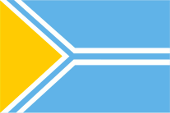
since 2002,
National flag,
ratio = 2:3,
Source, by:
Flags of the World




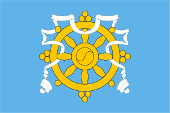
1914–1921,
Flag of the Russian Protectorate of Uryankhay,
Source, by:
Wikipedia (EN)



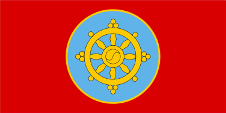
1921–1926,
Flag of the People's Republic of Tannu-Tuva,
ratio = 1:2,
Source, by:
vectorization by Orange Tuesday,
Public domain, via Wikimedia Commons



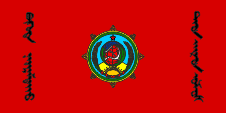
1926–1930,
Flag of the People's Republic of Tannu-Tuva,
ratio = 1:2,
Source, by:
Lumia1234,
Public domain, via Wikimedia Commons




1930–1935,
Flag of the People's Republic of Tannu-Tuva,
ratio = 1:2,
Source, by:
Lumia1234,
Public domain, via Wikimedia Commons




1935–1941,
Flag of the People's Republic of Tannu-Tuva,
ratio = 1:2,
Source, by:
Lumia1234,
Public domain, via Wikimedia Commons



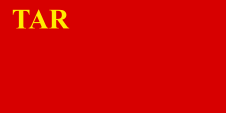
1941–1943,
Flag of the People's Republic of Tannu-Tuva,
ratio = 1:2,
Source, by:
World Statesmen



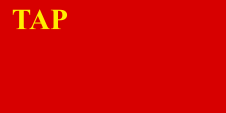
1943–1944,
Flag of the People's Republic of Tannu-Tuva,
ratio = 1:2,
Source, by:
World Statesmen



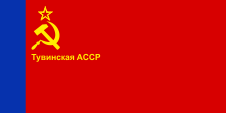
1962–1971,
Flag of the Tuvan Autonomous Soviet Socialist Republic,
ratio = 1:2,
Source, by:
World Statesmen



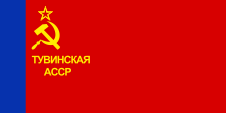
1971–1978,
Flag of the Tuvan Autonomous Soviet Socialist Republic,
ratio = 1:2,
Source, by:
World Statesmen



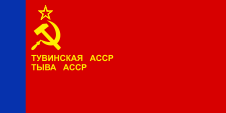
1978–1992,
Flag of the Tuvan Autonomous Soviet Socialist Republic,
ratio = 1:2,
Source, by:
World Statesmen



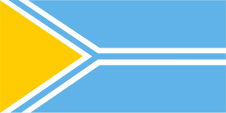
1992–2002,
National flag,
ratio = 1:2,
Source, by:
World Statesmen



look also:
Flag history of the soviet republics of the USSR

The current flag of Tuva was introduced on 17th or 18th of September in 1992. It shows a light blue bunting and a yellow isosceles triangle on the mast. The triangle is framed by a light blue ypsilon with a white border, which continues across the centre of the flag to the waving end. The colours of the flag are probably intended to recall the first flag of Tuva, when the country achieved independence from China with the support of Russia in 1914. Yellow stands for prosperity and is the colour of Buddhism, blue stands for courage and strength and for the sky and is the colour of the Turkic peoples, Tatars and Mongols, white stands for silver, virtue and purity. The ypsilon symbolises the confluence of the Great and Little Yenisei near the capital Kysyl. On 8th of February in 2002, the aspect ratio of the flag was changed from 1:2 (previously common in the Soviet Union) to 2:3.
The shades of the colours of the flag seem to be defined, at least the following HEX colour specifications can be found, from which Pantone colour shades can be derived: Light blue #63B3E6 = Pantone 2915 C, Yellow #FECC00 = Pantone 123 C. In practice, however, flags showing a darker blue can also be seen.
Shortly after gaining independence from China, a flag was introduced that showed a single-coloured light blue bunting with a golden khorlo, the Buddhist wheel of doctrine, decorated with white ribbons. By 1930, the Buddhist symbolism was gradually replaced by the flags used, which increasingly showed communist red. From 1930 onwards, only communist symbolism could be seen, and from 1941 only the initials of the country as three golden letters in the upper corner of a red flag.
The flags, which were used in the Soviet era corresponded all to the same pattern as it was intended for the Soviet Republics: frequently only a single-coloured red bunting with a golden inscription, showing the name of the country. Sometimes only as a shortcut, sometimes the full name, sometimes only in Russian or even multilingual. From about 1937 hammer, sickle and star were sometimes added. From about the mid-50s multicolored flags were introduced for the republics of the Soviet Union, whose knitting patterns had to be taken over by the subordinated autonomous Soviet republics. For Tuva, this meant that it had to orientate itself on the flag of the Russian Soviet Federative Republic (Soviet Russia).
Source:
Flaggen Enzyklopädie,
1.) Wikipedia (EN),
2.) Wikipedia (EN),
Volker Preuß

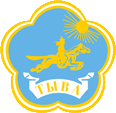
Coat of arms of the Republic of Tuva,
Source, by:
Wikipedia (RU)

The current coat of arms of Tuva was adopted on 17th of September in 1992. The shape of the coat of arms is a stylised image representing the ideas of the ancient Turkic peoples about the structure of the world. In the centre is a Tuvan horseman riding towards the sun. It symbolises the traditional way of life and the basic economic activity of the inhabitants. The sun symbolises the Tuvans' desire for high ideals, peace and prosperity. The banner bearing the name of the state in Cyrillic letters in gold is a "kadak", a ritual long scarf that reflects the hospitality and friendliness of the people of the Republic of Tuva. The colours also have their meaning: blue symbolises clear skies, high goals, mutual respect and harmony in society and it is the colour of the Turkic peoples, Tatars and Mongols. White symbolises purity, virtue, openness and independence. Yellow (gold) stands for prosperity and is the colour of Buddhism. A similar coat of arms, supplemented by communist symbols, was already in use between 1933 and 1941 and neighbouring Mongolia also uses a similar image in its coat of arms.
Source:
Wikipedia (EN),
Wikipedia (RU),
Volker Preuß

Geographical position within Russia:
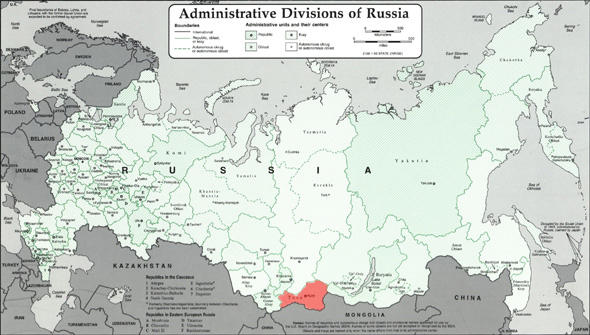
Source: Freeware, russiamap.org, modyfied by: Volker Preuß
enlarge – click or tap here
Map of the country:
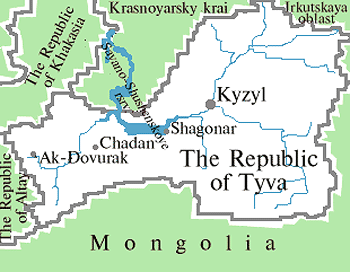
Source: Russiatrek

Area: 65.098 square miles
Inhabitants: 308.000 (2010), thereof 89% Tuvans, 10% Russians, 1% Komi, Khakass, Chinese, Mongol
Religions: mostly Buddhists (Tibetan Buddhism), some Old Believers of Russian-Orthodox Christians, Russian-Orthodox Christians, a few animists
Density of Population: 5 inh./sq.mi.
Capital: Kyzyl, ca. 110.000 inh. (2010)
official Languages: Tuvan, Russian
Currency: Russian currency
Time Zone: GMT + 7 h
Source: Wikipedia (DE)

Antiquity · evolution of the Tuvin nation from Scythic, Mongol and Turk tribes
1207 · conquest by the Mongols under Dshingis Khan
1227 · death of Dshingis Khan, partition of his empire under his four sons, Uegedei got the today’s China, Korea and the today’s Mongolia and Mandshuria and he became nominated to successor and Grand Khan, his son Kublai Khan established the Yuan dynasty
14th–15th century · China loses control over Tuva, rule of Uigurs, Kirghiz, Oirats and Mongols
1696 · the Chinese Manchu dynasty conquers the territories of the Mongols, and in this way also Tuva, Tuva becomes the Province of Tannu-Uryankhay
10th of October 1911 · overthrow of the monarchy in China, agitations, separatist ambitions
October to December 1912 · independence for Tibet, East Turkestan (Dsungaria) and the Outer Mongolia (including the Province of Tannu-Uriankhai)
1912 · separation (supported by Russia) of Tannu-Uriankhai from China, State of Tannu-Tuva
1914 · Tannu-Tuva becomes a Russian protectorate (Protectorate of Uryankhay Region), a later treaty between Russia and China grants Tannu-Tuva the independence under nominal Chinese supremacy
1917 · Lenin revolt in Russia, Tannu-Tuva declares once more its independence
1917–1921 · civil war in Tannu-Tuva, victory of the Russian bolshevists
14th of August 1921 · proclamation of the People’s Republic of Tannu-Tuva as a satellite state of Soviet Russia
1925 · Kuular Donduk becomes president of the country, the Buddhism becomes state religion
1926 · guaranty treaty between Soviet Union, Mongolia and Tannu-Tuva
January 1929 · assassination of Kuular Donduk by order of Stalin
1930 · introduction of the Latin alphabet
1940 · introduction of the cyrillic alphabet
1930–1944 · collectivation, sovietization, ousting of Buddhism and ancient religions
11th of October 1944 · Tannu-Tuva proposes the annexation to the Soviet Union, Tannu-Tuva becomes an autonomous territory within Soviet Russia
10th of October 1961 · the Tuvin Autonomous Territory becomes an autonomous socialistic soviet republic within Soviet Russia
November 1991 · Tuva proclaims its independence
31st of December in 1991 · the Soviet Union dissolves, the constitution of the Russian Socialist Federative Soviet Republic (RSFSR, Russia), a former substate of the Soviet Union, remains in force for the time being
25th of December in 1993 · a new constitution for Russia (Russian Federation) comes into force, and the relationships with the members of the federation is re-regulated in this way
Source:
Atlas zur Geschichte,
World Statesmen,
Russiatrek,
Die Völker der Erde,
Wikipedia (D)

The name "Tuva" is of Russian origin and has its roots in the Tuvins, the here living Turk nation. The Tuvins call themselves "Tyva-Kishi" und their country "Tyva". Older denominations for the Tuvins are: "Soyons" and "Uryankhay". The name "Tannu-Tuva" means "Land of the Tuvins in the Tannu-Ola Mountains", because further Tuvins live in Mongolia, in Russia, in China and in Upper Altay.
Source:
Die Völker der Erde, Volker Preuß

Surf tip:


![]()

















